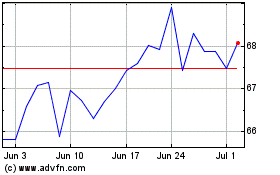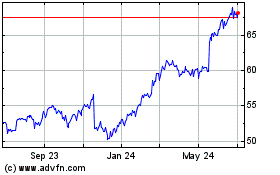By Laura Stevens and Khadeeja Safdar
Amazon.com Inc. unveiled Monday its first small-format grocery
store, Amazon Go, one of at least three brick-and-mortar formats
the online retail giant is exploring as it makes a play for an area
of shopping that remains stubbornly in-store.
Two of the other store formats Amazon is considering are bigger
than the convenience-style Go store, according to people familiar
with the matter. In November, Amazon's technology team approved a
proposal to open large, multifunction stores with curbside pickup
capability, clearing the way to start hiring and planning,
according to one of the people.
Two drive-through prototype locations, which don't offer an
in-store shopping option, are also slated to open within the next
few weeks in Seattle, the people said.
Amazon envisions opening more than 2,000 brick-and-mortar
grocery stores under its name, depending on the success of the new
test locations, according to the people. By comparison, Kroger Co.
operates about 2,800 locations across 35 states.
Adding grocery pickups will be "part of their secret sauce in
terms of all of the different ways in which they can engage the
customer in bringing the product to them," says Bill Bishop, chief
architect at grocery and retail consultancy Brick Meets Click.
"Everyone is looking at grocery because of frequency. Frequency
guarantees that you have density."
The developments are the next step in Project Como, Amazon's
plan to capture more food sales, opening the door to a key driver
of consumer spending that would broaden the online retailer's
increasing dominance in the retail market.
It will also help Amazon better compete against rivals such as
Target Corp. and Wal-Mart Stores Inc., which plans to expand a
service that lets shoppers order online and pickup curbside to
1,000 stores by the end of next year.
An Amazon spokeswoman declined to comment.
Until now, Amazon has centered its grocery strategy around
Amazon Fresh, a subscription service that promises quick food
delivery for online orders. But delivering groceries is
logistically complex, requiring fast delivery for cold items as
part of large orders on less profitable routes, where stops are
spread far apart. And many consumers still prefer to touch, smell
and pick out fresh items like fruits and vegetables for
themselves.
Online purchases comprise about 1% of the $674 billion market
for edible groceries in the U.S., according to Kantar Retail.
The Amazon Go store, at roughly 1,800 square feet in downtown
Seattle, resembles a convenience store-format in a video Amazon
released Monday. It features artificial intelligence-powered
technology that eliminates checkouts, cash registers and lines.
Instead, customers scan their phone on a kiosk as they walk in, and
Amazon automatically determines what items customers take from the
shelves. After leaving the store, Amazon charges their account for
the items and sends a receipt.
Meanwhile, in the suburban Seattle neighborhood of Ballard, a
handful of workers on Monday were finishing up one of Amazon's two
drive-through prototypes in the area, which according to the people
close to the situation are slated to open in the next few weeks.
The wood-paneled building with green trim and an overhang appeared
to have at least three covered bays for cars to pull up and pick up
orders, with a paved driveway in front.
The third concept, the newly approved multi-format store,
combines in-store shopping with curbside pickups, according to the
people. It will likely adopt a 30,000- to 40,000-square-foot floor
plans and spartan stocking style like European discount grocery
chains Aldi or Lidl, offering a limited fresh selection in store
and more via touch-screen orders for delivery later. Stores in this
format, which are smaller than traditional U.S. grocery stores,
could start appearing late next year.
That concept bears strong resemblance to a 2013 report by former
Deloitte consultant Brittain Ladd, who now works for Amazon Fresh.
The paper, previously reported by GeekWire, describes stores
focusing on a core 20% of foods -- eggs, dairy, meat, fruit,
vegetables and bread -- that generate 80% of traditional grocery
sales, with drive-through and touch-screen ordering options.
Amazon declined to make Mr. Ladd or other Amazon executives
available for comment.
While Amazon is moving into brick-and-mortar grocery shopping,
other large retailers are expanding their online services.
Wal-Mart's curbside pickup service offers some convenience without
the cost of home delivery. Last week Wal-Mart opened its second
Pickup and Fuel store in Denver, a small-format store that offers a
limited selection of fresh food, snack and gas as well as allowing
shoppers to pick up online grocery orders.
Target in recent months began considering a pilot to deliver its
own groceries, which face declining sales as too few shoppers are
buying perishable items like milk and eggs. But it hasn't moved
forward with the idea, according to a person familiar with the
matter.
"While we don't currently have plans to pursue a full-service,
Target-owned grocery delivery service in the near term, we will
continue to discuss the idea, among many others, and assess if it
is the right fit for the future," said Target spokeswoman Katie
Boylan.
The retailer currently offers a grocery-delivery service in
select cities through a partnership with Instacart Inc., a
grocery-delivery startup. However, executives are concerned the
service is boosting Instacart's brand rather than the retailer's
own brand, according to the person.
As Target pauses grocery delivery, Amazon envisions filling in
the gap. The online retailer hopes to one day function as a
grocery-delivery service and distributor for brick-and-mortar
retailers, according to one of the people, a move that will help
lower its own costs as it builds out its own transportation
network. The more deliveries, the more cost-effective its service
becomes -- including lower food prices as the online retailer
purchases more.
Analysts say that many retailers would be reluctant to hand over
the reins to Amazon.
Grocery sales produce slim profits for chains like Target and
Wal-Mart but are important because they drive traffic to their
stores where consumers buy higher-margin products like apparel and
home items.
A future in which Amazon is delivering Target's groceries is
"very very very unlikely," said Amy Koo, principal analyst at
Kantar Retail. "Target is not going to give that benefit to
Amazon."
--Jay Greene and Greg Bensinger contributed to this article.
Write to Laura Stevens at laura.stevens@wsj.com and Khadeeja
Safdar at khadeeja.safdar@wsj.com
(END) Dow Jones Newswires
December 05, 2016 18:59 ET (23:59 GMT)
Copyright (c) 2016 Dow Jones & Company, Inc.
Walmart (NYSE:WMT)
Historical Stock Chart
From Aug 2024 to Sep 2024

Walmart (NYSE:WMT)
Historical Stock Chart
From Sep 2023 to Sep 2024
